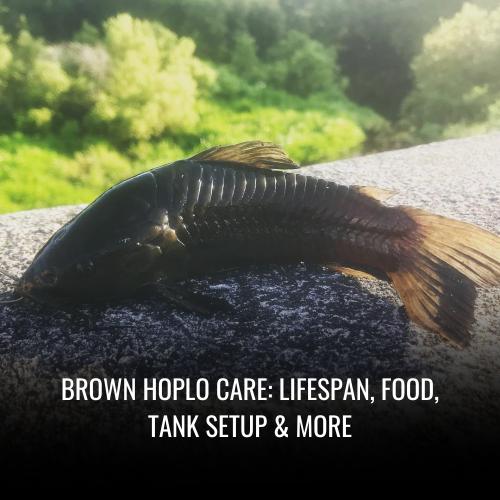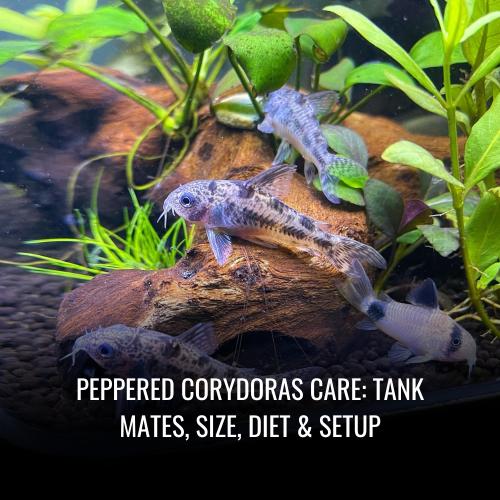Fairy cory Care: Tank Size, Lifespan, Food & More
This post contains affiliate links. As an Amazon Associate, we earn from qualifying purchases.
Fairy cory, also known as Corydoras aeneus, are small freshwater fish native to South America. These petite swimmers are typically about two inches in size and have a lifespan of around 5 years when provided with proper care. Their natural habitat includes slow-moving rivers, streams, and flooded areas, where they are known for their gentle behavior and sociable nature.
| Attribute | Information |
|---|---|
| Scientific name | Corydoras habrosus |
| Common name | Fairy Cory |
| Family | Callichthyidae |
| Usual size in fish tanks | 1.5 inches (3.8 cm) |
| Recommended pH range | 6.0 – 7.8 |
| Recommended water hardness (dGH) | 5 – 19 |
| Recommended temperature | 72°F – 78°F (22°C – 26°C) |
| Reproduction | Egg scatterer, requires soft, acidic water for breeding |
| Origin | South America, specifically Brazil and Colombia |
| Temperament to its own species | Peaceful, sociable |
| Temperament toward other fish species | Peaceful, non-aggressive |
| Usual place in the tank | Bottom dweller |
| Lifespan | 3 – 5 years |
| Tank size requirement | 15 gallons (57 liters) or more for a small group |
| Filtration system | Requires good filtration to maintain clean water |
| Sexual dimorphism | Females tend to be larger and have a rounder belly |
| Substrate cleaning | Active substrate cleaner, uses its barbels to sift through the substrate |
Scientific Name
The enchanting Fairy Cory, known to the scientific community as Corydoras atropersonatus, is a member of the diverse Callichthyidae family. These captivating creatures hail from the biodiverse waters of South America, where they have adapted to thrive in its unique ecosystems.
Aquarium Water Parameters:
- pH Range: 6.3 – 7.7
- Water Hardness: 7 – 18°N (125 – 321.43 ppm)
Spanning a modest 4 to 5 cm (1.57 – 1.97 inches) in an aquarium setting, the species falls within an intermediate size range for freshwater fish. To ensure their wellbeing, aquarium enthusiasts should maintain water parameters that closely resemble their natural habitat. With a recommended pH level at the slightly acidic to neutral range and moderate water hardness, these conditions reflect the environment from which the Fairy Cory originates.
Average Size
The intriguing Fairy Corydoras, including its different variants, has specific growth markers tied to its development into mature fish. A typical Fairy Cory, Corydoras atropersonatus, has an average adult size that ranges from 3.8 to 5.1 cm (1.5 to 2 inches). It’s at 2.25 inches that the Fairy Corydoras reaches maturity, presenting a charming exhibit of growth within its species.
Similarly, the Mega Fairy Spotted Cory, known as Corydoras sychri, also boasts a mature size slightly larger than its standard counterpart, stretching to a full length of 2.25+ inches upon adulthood. This growth expectancy ensures that the Fairy Corydoras fits comfortably in aquariums, making a minimum tank size of 20 gallons ideal for adequate mobility and display.
Here’s a quick reference for the average sizes:
| Species | Average Adult Size | Maturity Size | Suggested Tank Size |
|---|---|---|---|
| Corydoras atropersonatus | 3.8 – 5.1 cm | 2.25 inches | 20+ gallons |
| Corydoras sychri | Over 2.25 inches | 2.25+ inches | 20+ gallons |
This information is vital for hobbyists aiming to provide a suitable environment that caters to the needs of these lovely active shoalers, ensuring their captivating appearance can be enjoyed for years to come.
Lifespan
The enchanting Fairy Corydoras, native to Peru in the diverse waters of South America, typically enjoys a lifespan of 8-12 years when in their natural habitat. However, with diligent care within an aquarium setting, these charming catfish can astonishingly surpass this, living between 15-25 years when conditions are ideal. Critical to reaching such advanced ages are factors that include a high-quality diet, stringently maintained water parameters, and harmonious tank mate selections.
To bolster the longevity of these beautiful species, it is paramount that owners pay close attention to their needs, creating an ecosystem that closely mirrors their natural environment. Below is a brief outline of parameters that can affect Fairy Corydoras’ lifespan:
| Factors Influencing Lifespan | Impact |
|---|---|
| Diet | A varied diet contributes to health and longevity. |
| Water Quality | Clean, well-oxygenated water ensures thriving conditions. |
| Tank Compatibility | Peaceful companions reduce stress for Fairy Corydoras. |
Emphasis on the right aquarium conditions and maintenance can lead to these lovely active shoalers gracing your aquatic displays for decades, making their presence a lovely sight in the long-term home aquarium.
Natural Habitat
The Fairy Spotted Cory, scientifically known as Corydoras atropersonatus, is a native of the Nanay River Basin in Loreto, Peru. These fascinating inhabitants of South America thrive in the rapidly flowing blackwaters of the region’s floodplain lakes and quaint forest streams.
Encased in untouched natural beauty, their environment is distinct with white sandy substrates which line the shallow open sands of the crystal-clear or slightly tannin-stained waters. Although there is a notable absence of aquatic vegetation, this is compensated by an abundance of submerged wood, such as driftwood, and a rich carpet of leaf litter. These features create a labyrinth of hiding spots critical to the Fairy Spotted Cory’s wellbeing.
Consider the table below to envision the characteristics of their natural dwelling place:
| Habitat Feature | Description |
|---|---|
| Water Type | Blackwater, fast-flowing |
| Substrate | White sand |
| Vegetation | Sparse aquatic plants |
| Common Elements | Submerged wood, driftwood, leaf litter |
| Clarity | Clear to slightly tannin-stained |
| Region | Nanay River Basin, Loreto, Peru, South America |
This serene backdrop not only provides shelter but is also crucial for their behaviors, such as foraging and spawning, embracing the essence of these majestic creatures in their pure form.
Appearance
The Fairy Spotted Cory, Corydoras atropersonatus, is a charming yet modestly adorned species of catfish. While it may not boast the vibrant hues of some marine fish, its subtle beauty is undeniable. Mature fish exhibit a base coloration of a soft, muted brown tinged with a gentle greenish glow, reflecting the leafy terrain of their natural habitat.
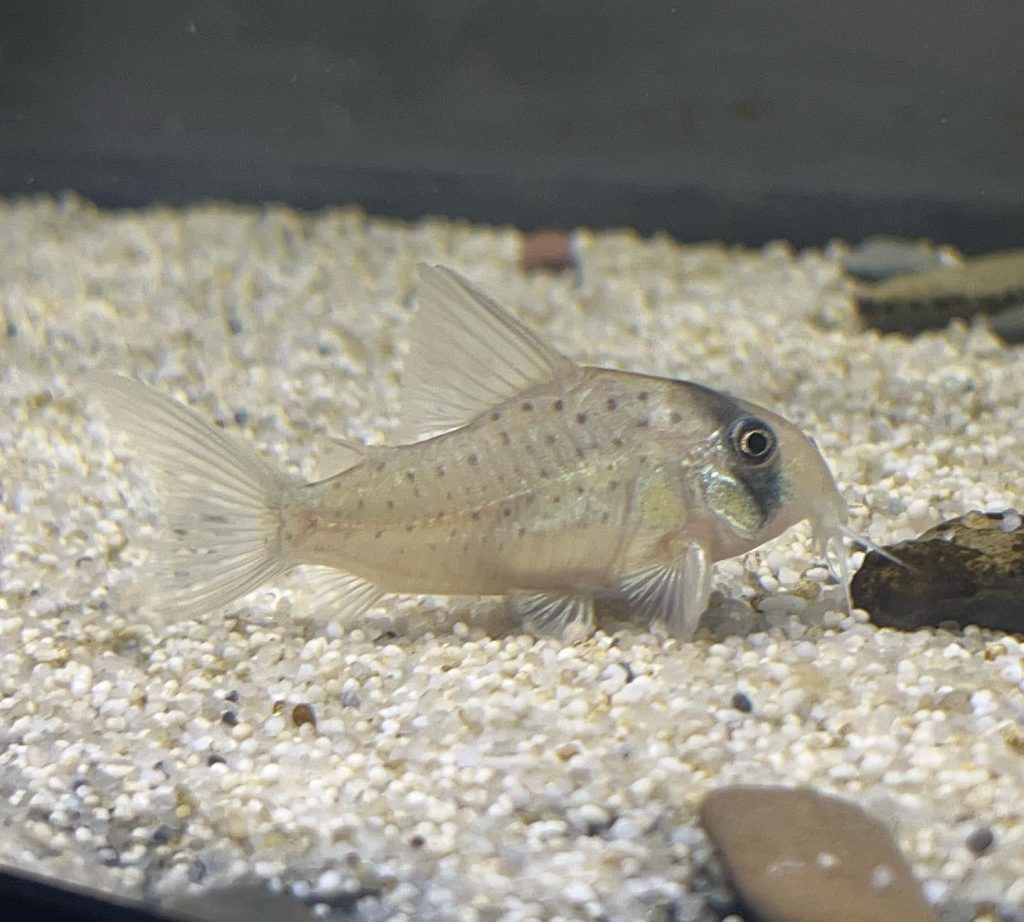
Their physique contributes to their quaint allure, marked by a slender body and a delicately pointed snout—features that distinguish the C. atropersonatus from its kin. It is in these characteristics that the fish exhibits its adeptness at blending into the soft and acidic waters of northern Peru and Ecuador. As a result, they serve as a lovely sight in any aquarium setting, especially when keeping a range of aquarium fish from similar cooler water biomes.
Noteworthy distinctions can be observed through Sexual Dimorphism—females of this species may grow slightly over two inches, with males maintaining a somewhat smaller stature. Here’s a quick visual overview of their appearance:
| Feature | Description |
|---|---|
| Size | Females > 2 inches, Males slightly smaller |
| Coloration | Muted brown with greenish tint |
| Body Shape | Slender body, pointed snout |
| Habitat Influence | Blends with natural environment |
These active shoalers embody elegance through simplicity, making them a beautiful species that captivate with understated grace rather than flashy colors.
Behavior & Temperament
The Fairy Cory, scientifically known as Corydoras atropersonatus, is epitomized by its peaceful demeanor and non-aggressive interactions with other aquarium inhabitants. Best known for their gregarious and shoaling nature, they find comfort in numbers, typically seeking the companionship of their own kind. They spend much of their time foraging through the substrate, using sensitive barbels to locate food, which aligns with their non-fin-nipping behavior.
The Fairy Cory is truly a cool fish that prefers harmony over conflict, making them excellent candidates for communal tanks. Keeping them in proper conditions, such as cooler water with a soft sandy substrate, is crucial to maintain their wellbeing and characteristic friendly temperament.
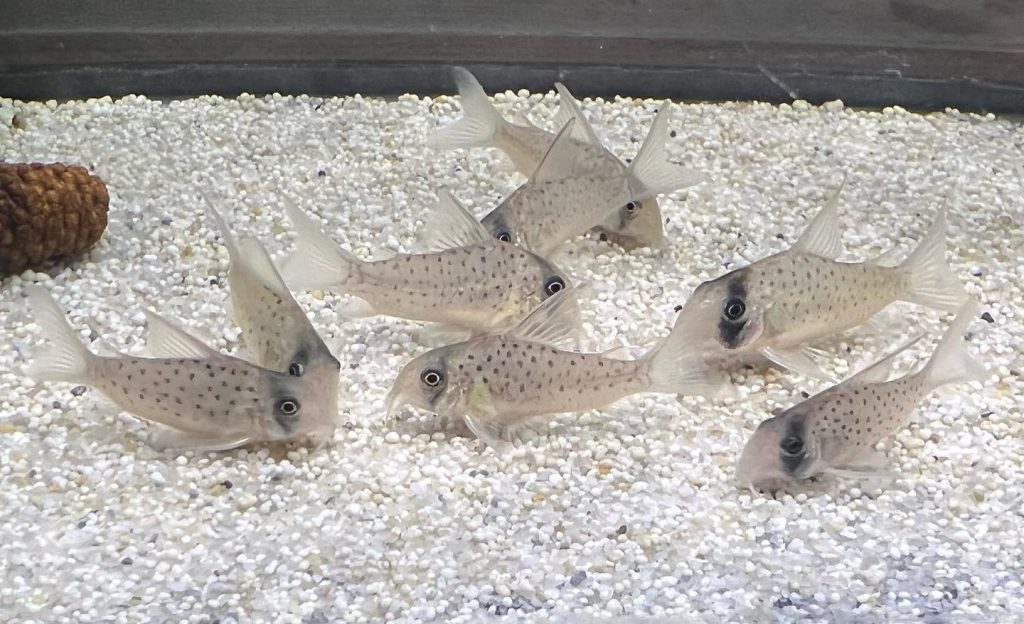
Are Fairy Cory Fin Nippers?
Fairy Corys are not known to engage in fin-nipping behavior. Their peaceful nature and preoccupation with sifting through substrate for food keep them from bothering other fish. This lack of aggression is one of the facets that make them beautiful species and a lovely sight in any aquarium setup.
Are Fairy Cory Aggressive To Each Other & Other Fish?
Aggression is rarely, if ever, an issue with Fairy Corydoras. They coexist seamlessly with conspecifics and are adaptable enough to thrive among a diversity of non-aggressive tank mates. Their compatibility with a variety of species reinforces the idea of them as a wonderful addition to the harmonious community aquarium.
Are Fairy Cory Friendly To Each Other & Other Fish?
Embodying friendliness in every sense, Fairy Corys exhibit active shoaling behavior and a communal spirit that adds tranquility to an aquarium. They are indeed friendly towards each other and maintain a placid presence amongst other peaceful fish, which is why they are considered a great choice for a mature and diverse community aquarium.
Are Fairy Cory Schooling Fish?
Yes, Fairy Corys are inherently schooling fish. They showcase their natural behavior most vividly when kept in groups, often seen swimming in harmony with their shoal. As active shoalers, they are at their best when in the company of five or more of their own kind, providing observers with an endearing spectacle of aquatic teamwork.
Can You Have Just One Fairy Cory In The Tank?
It is not recommended to keep just one Fairy Cory in a tank due to their sociable nature. Lone Corydoras may suffer from stress and show inhibited behavior, thus not reaching their maximum potential for activity and health. For their happiness and full expression of natural behavior, Fairy Corys should be kept in shoals.
Do Fairy Cory Need To Be In Groups?
Undoubtedly, Fairy Corys need to be kept in groups. A minimum of five is often suggested to ensure they feel secure and display their natural, confident behavioral patterns. A species-only tank is recommended for breeding purposes to protect the eggs from predation, keeping the lineage of this beautiful species going strong in the aquarium community.
In summary, the table below offers a quick glance at the preferred social configuration for Fairy Corydoras:
| Social Preference | Description |
|---|---|
| Fin Nipping | Not prone to fin nipping |
| Aggression | Non-aggressive to conspecifics and other species |
| Friendliness | High—friendly and peaceful with others |
| Schooling | Yes, shoaling behavior is prominent |
| Solo Housing | Not recommended; best in groups |
| Group Size | Minimum group of 5 for optimal wellbeing |
Food & Diet
Understanding the dietary needs of the Fairy Cory, or Corydoras atropersonatus, is fundamental for keeping these South American natives healthy and vibrant in your aquarium. A varied diet is essential for these omnivorous catfish, and knowing what they eat, as well as what they do not, is key to providing proper nutrition.
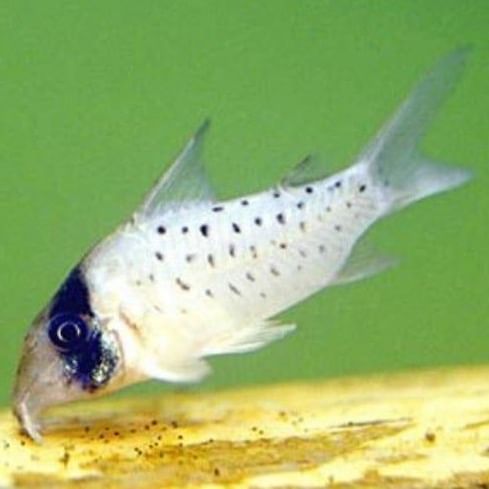
Do Fairy Cory Eat Algae?
It’s a common misconception that catfish like the Fairy Cory are avid algae eaters. While they may ingest incidental algae while foraging in the substrate, it should not be considered a dietary staple. In their natural habitat, Fairy Corydoras sift through the gravel substrates for small insect larvae and other organic matter, but algae consumption is minimal. It is important to maintain a balanced diet inclusive of algae-based foods, but to rely on more efficient algae eaters for tank maintenance.
Do Fairy Cory Eat Shrimp?
Fairy Corydoras demonstrate a flexible diet that can include small invertebrates, such as shrimp, in the wild. However, in a community aquarium, they often cohabitate with shrimp without issue. Juvenile and small shrimp could be at risk if not provided with enough hiding spaces, but generally speaking, with a well-fed Fairy Cory population, shrimp remain fairly safe. Regular feeding with a mix of sinking pellets, flake food, and frozen foods should keep the Corydoras well-nourished and less inclined to prey on tankmates.
Do Fairy Cory Eat Bloodworms?
Bloodworms are a treat that Fairy Corys accept eagerly. They can be fed as supplementary food in the form of live, frozen, or freeze-dried to diversify the diet of your fish. Bloodworm feeding should be limited to once or twice a week, acknowledging their carnivorous side while balancing it with commercial fish foods that fulfill their omnivorous requirements. Avoid relying solely on bloodworms, as their high protein content could potentially cause health issues if used excessively.
Do Fairy Cory Eat Mosquito Larvae?
Mosquito larvae are a natural and nutritious source of food that Fairy Corys would encounter in their South American rivers. In an aquarium setting, these larvae can be a beneficial supplement, offering a variation from the commercial diets of flakes and pellets. When fed in moderation, larvae can help replicate their natural feeding habits and support their well-being.
Do Fairy Cory Eat Planaria?
Fairy Corys may ingest small planaria as part of their scavenging behavior, although this is an incidental and not a regular component of their diet. Planaria can be unwelcome guests in the aquarium, and it’s generally advisable to control these flatworms through proper tank hygiene and maintenance, rather than relying on fish to manage the population.
Do Fairy Cory Eat Plants?
Fairy Corydoras are not herbivorous and do not consume aquarium plants. Their presence in a planted tank brings the benefit of active substrate sifting without the risk of plant damage. Introducing live plants can actually mirror their natural environment, offering them cover and enriching their habitat. The focus on maintaining a clean tank and ensuring regular water changes remains paramount for the health of both your Fairy Corys and aquatic plants.
To summarize their dietary habits, the following table details the typical food consumption of Fairy Corys:
| Food Type | Consumption | Notes |
|---|---|---|
| Algae | Incidental | Not a reliable algae-eater in the aquarium |
| Shrimp | Occasional | Small shrimp are at risk without hiding spots |
| Bloodworms | Supplemental | Treat, feed sparingly once or twice a week |
| Mosquito Larvae | Supplemental | Nutritious natural food, feed in moderation |
| Planaria | Incidental | Not part of the regular diet |
| Plants | None | Do not eat or damage aquatic plants |
In addition to the table, here are points to keep in mind for a Fairy Cory’s diet:
- Use a high-quality sinking pellet as a staple to ensure they are consuming enough nutrients.
- Complement their diet with occasional live or frozen foods such as bloodworms, mosquito larvae, and baby brine shrimp.
- Flake food can be offered, but ensure it reaches the bottom of the tank where Fairy Corys forage.
- Offer blanched vegetables as a source of fiber to promote digestibility.
- Do not overfeed and remove uneaten food promptly to prevent water quality issues.
Proper feeding contributes greatly to the health, coloration, and activity level of Fairy Corys, making them a beautiful species and active shoalers that are a lovely sight in the aquarium community.
Sexing: Male vs Female
Determining the sex of Fairy Corydoras is typically straightforward for seasoned aquarists, revealing clear variations in body shape and patterning. A visual examination from above showcases that females have a broader body outline, especially noticeable in their pronounced underbelly, accommodating for future spawning.
| Sex | Body Shape | Coloration Pattern | Length | Activity Level |
|---|---|---|---|---|
| Male | Narrower | Cream with brown-grey spots | Shorter | More Active |
| Female | Broader with larger underbelly | Different from males | Longer | Less Active |
Males are distinctly slimmer and shorter in length when compared to their female counterparts. They display a cream background with brownish-grey spots along their flanks, making them easily distinguishable once the fish reach maturity.
Behaviors also vary between the sexes. Males typically exhibit more vigor, frequently displaying dynamic and spirited actions, particularly during courtship rituals. Understanding these differences in appearance and behavior is essential when breeding and observing the social dynamics within your aquarium’s community.
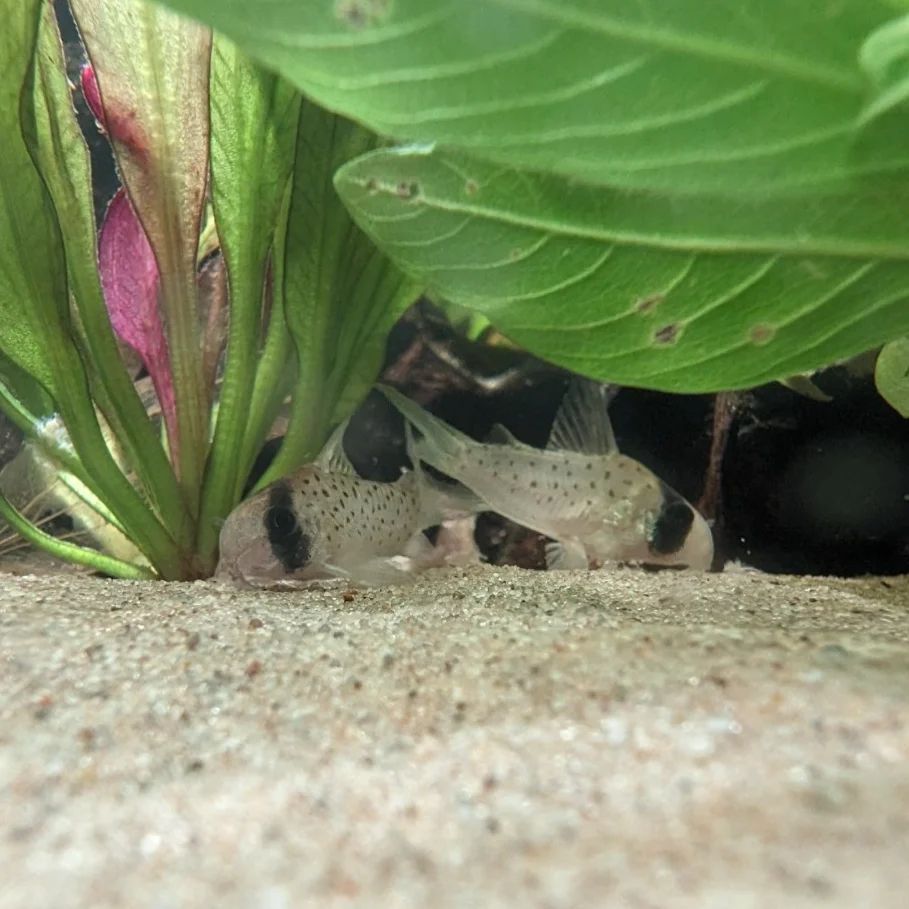
Fairy cory Tank Mates
The tranquil Fairy Cory (Corydoras atropersonatus) thrives in company equal in calmness, making certain tank mates more suitable than others. Ideal companions for these serene creatures are Dwarf Cichlids, Loaches, and non-aggressive Catfish varieties. They relish the peaceful existence and flourish in environments free from aggressive or large fish, safeguarding their delicate demeanor. For those with a breeding focus, consider establishing a species-only tank. This not only prevents predation on their eggs but also promotes a harmonious breeding setting.
Small, peaceful midwater species such as Pencilfish, Tetras, and Rasboras serve as excellent dither fish, encouraging Fairy Corys to more confidently showcase their beauty. Here’s a snapshot list of congenial companions for the Fairy Cory:
- Dwarf Cichlids
- Loaches
- Peaceful Catfish
- Pencilfish
- Tetras
- Rasboras
Constructing a habitat that mirrors their natural South American waters—featuring sandy substrates, sections of driftwood, and subdued lighting—enhances their well-being. Ensure the inclusion of abundant shady patches provided by driftwood, rocks, or dense vegetation. Such a setup ensures a sanctuary for the Fairy Cory and its tank mates, fostering a tranquil and secure underwater world.
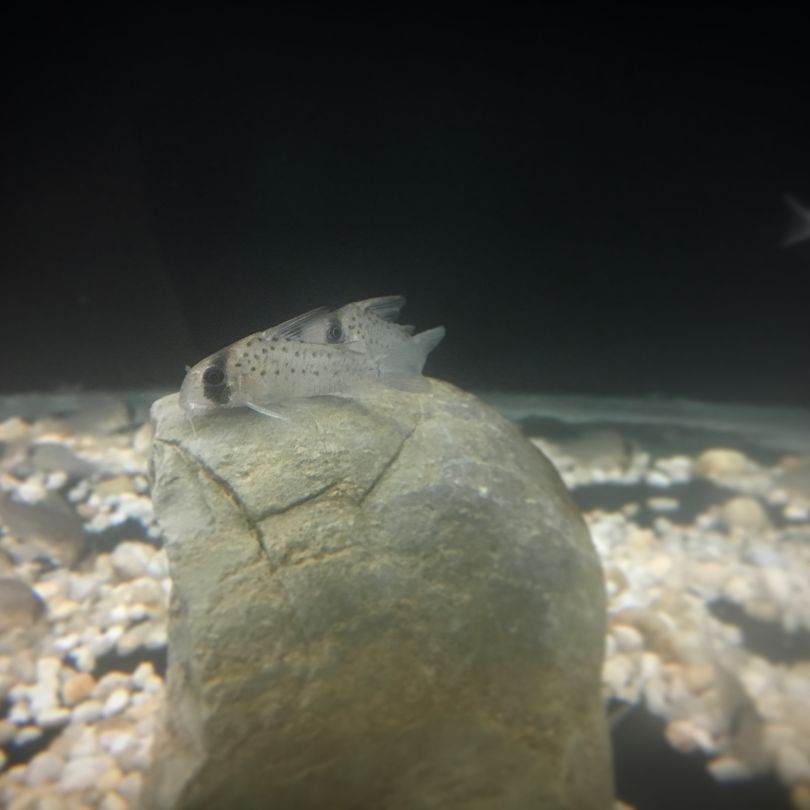
Aquarium Setup
Creating the perfect aquarium setup for Fairy Corydoras, also known as Corydoras atropersonatus, involves recreating aspects of their native South American rivers. A 20-gallon tank or larger is essential to provide ample swimming space and a sense of security for these active shoalers. A soft, sandy substrate is pivotal for their delicate barbels, while driftwood and dim lighting lend a sense of their natural murky habitat. Leaf litter and peat can be introduced for authenticity, but must be well-maintained to preserve water quality.
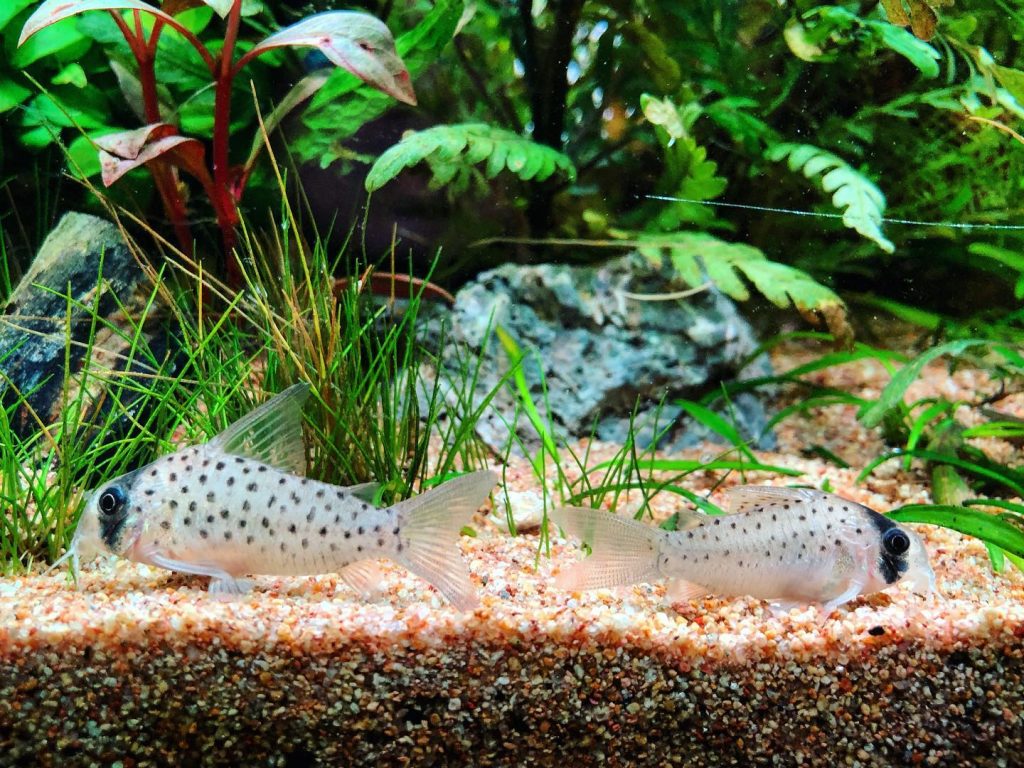
Ideal Tank Size
For a group of Fairy Corydoras, the ideal tank size starts at a minimum of 20 US gallons (76 liters). This space accommodates their sociable nature and offers sufficient room for swimming and the stretching of open sand areas vital for their well-being. They are a lovely sight when kept in groups, and larger tanks can enhance this spectacle. Given their size, often between 1.5-2 inches (3.8-5.1 cm), a spacious tank promotes healthy development and supports an enriching environment for these beautiful species.
Ideal Water Parameters
Keeping Fairy Corydoras healthy requires attention to water parameters that emulate their South American blackwater origins. The pH should range from 6.0 to 7.7, with a water hardness (dGH) of 7 – 18°N (125 – 321.43ppm). Consistent water temperature between 22-26°C (71.6-78.8°F) is conducive to their health and mimics their natural environment. Proper acclimation to these parameters, especially for fish shipping arrivals, is crucial for the longevity of the fish.
Water Parameters Table:
| Parameter | Ideal Range |
|---|---|
| pH | 6.0 – 7.7 |
| Water Hardness (dGH) | 7 – 18°N (125 – 321.43ppm) |
| Temperature | 22-26°C (71.6-78.8°F) |
Filtration
For Fairy Corys, filtration should be gentle yet effective, as strong currents are not a feature of their native environment. Choose a filtration system that provides mechanical, chemical, and biological filtration without creating excessive flow. Bubble-up sponge filters or hang-on-back filters with adjustable flow settings are both suitable. This will keep the water clean and maintain a stable environment, ensuring these peaceful catfish thrive.
Lighting
While the beautiful species of Fairy Corys don’t have special lighting needs, the right setup can enhance their environment and overall aquarium aesthetics. Soft, subdued lighting not only reflects their natural habitat but also promotes the growth of low-light plants such as Anubias. A standard aquarium light fixture is sufficient, but the placement and wattage should be chosen to avoid intense brightness, creating a comfortable and visually appealing home for these lovely, active shooters.
Common Possible Diseases & Prevention
Being aware of common health conditions is crucial for maintaining well-being. Diseases like heart disease, diabetes, cancer, and respiratory infections significantly impact lives. Fortunately, there are preventive measures for each.
Regular exercise and a healthy diet are two pillars of disease prevention. They can reduce the risk of chronic illnesses and enhance overall health. Additionally, it’s important to avoid smoking and limit alcohol consumption.
Routine check-ups and screenings are vital in detecting issues early, potentially saving lives. Vaccinations offer protection and are essential in preventing diseases like the flu and measles.
Practicing good hygiene, especially consistent handwashing, is a simple yet effective way to prevent the spread of infectious diseases.
Prevention Checklist:
- Regular exercise
- Healthy diet
- Avoid smoking
- Limit alcohol
- Regular check-ups
- Vaccinations
- Good hygiene practices
Implementing these steps can strengthen your defense against common health threats.
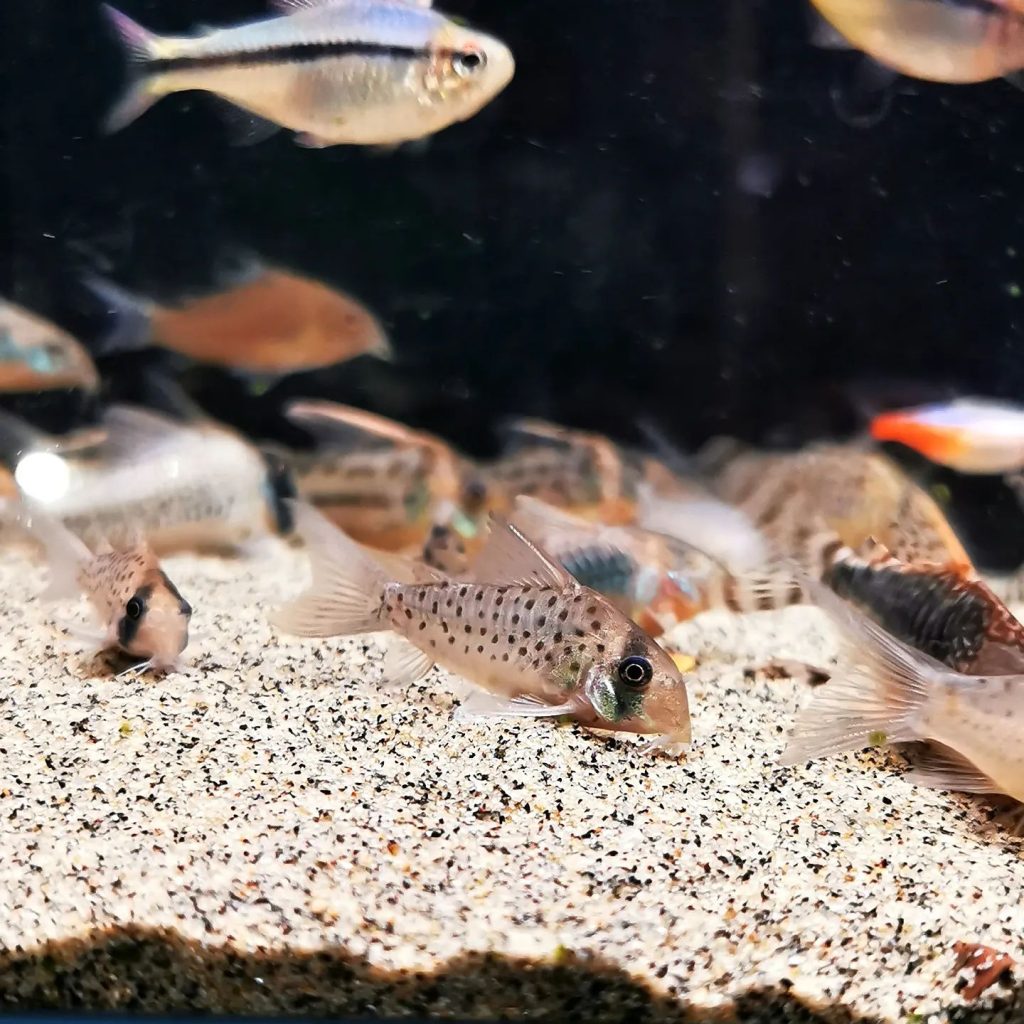
Breeding Fairy cory In Aquarium
Breeding Fairy Corydoras, a lovely sight among aquarium enthusiasts, can be a rewarding experience if done correctly. These peaceful, hardy fish, also known as Corydoras atropersonatus, are native to South America and exhibit a charming black mask and black spots, contributing to their popularity. To increase the chances of successful breeding, a species-only tank is recommended, as it prevents potential predators from snacking on the precious eggs.
When attempting to breed Fairy Corydoras, it’s important to replicate their natural habitat. A soft, sandy substrate, alongside the addition of driftwood, dim lighting, and dried leaves, creates an environment conducive to spawning. Since they thrive in cooler water, a large water change with slightly cooler water can often trigger the breeding process. Following this, a pair may form and engage in the classic T position to fertilize the eggs.
Although breeding records in home aquariums are scarce, these active shoalers are expected to spawn similarly to other Corydoras species. Fairy Corydoras show signs of Sexual Dimorphism, making it easier to distinguish males from females—females are usually larger and rounder than their male counterparts.
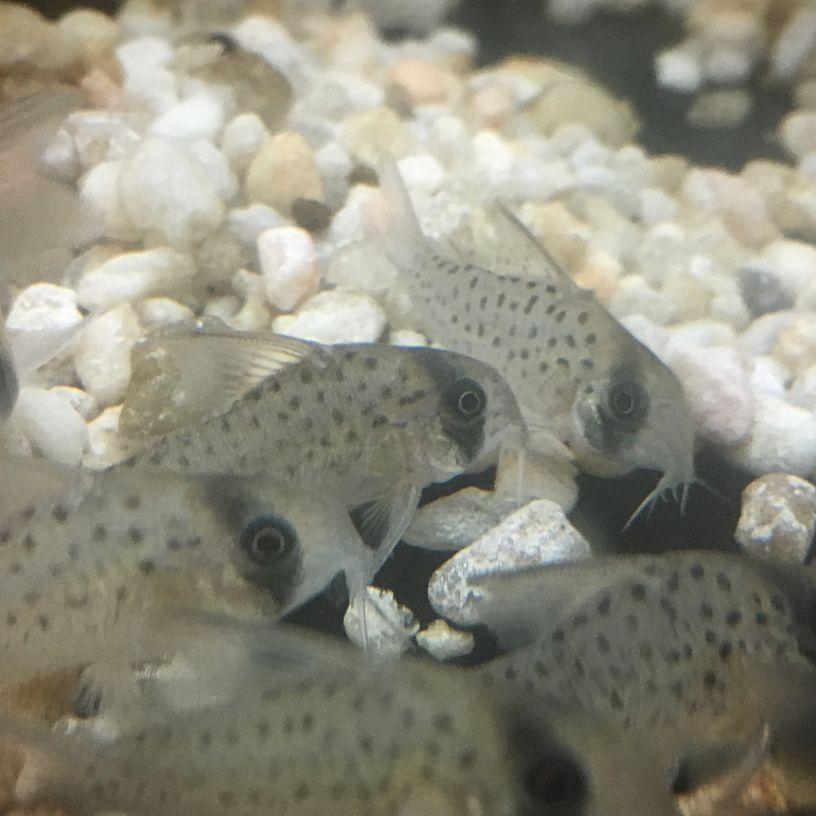
If you’re planning to breed these cool fish, keep them in groups as they are active shoalers. By providing the right water parameters and a tranquil environment, you’re setting the stage for these beautiful species to reproduce, creating a peaceful underwater ballet in your aquarium.



